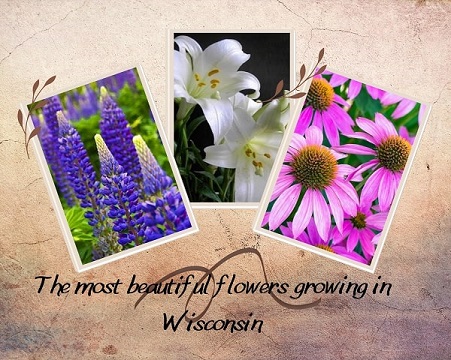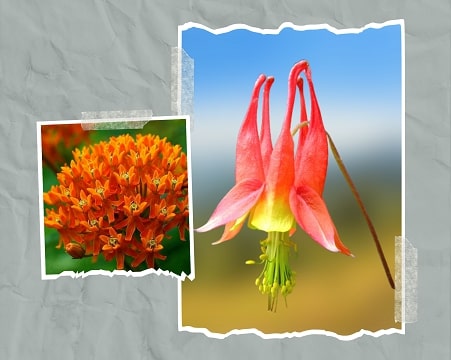The most beautiful flowers growing in Wisconsin
Many wild and potted flowers in yellow, blue, white and red colors grow in this region. We did a short research on flower varieties. Which flowers grow in your region? how to care for them? what are endemic flowers? we will look for answers to these questions.
Do flowers grow well in Wisconsin? Yes, flowers can grow well in Wisconsin, but it depends on various factors such as the specific flower species, climate, soil conditions, and gardening practices. Wisconsin has a diverse climate with cold winters and warm summers, which can affect the types of flowers that thrive in the region. Many flowers, both native and cultivated, can grow successfully in Wisconsin. Native wildflowers such as wild lupine, coneflowers, woodland phlox, and black-eyed Susans are well-adapted to the local climate and can flourish with minimal care. These native flowers are often resilient, attracting pollinators, and contributing to the local ecosystem.
In terms of cultivated flowers, there is a wide range of annuals, perennials, bulbs, and shrubs that can thrive in Wisconsin gardens. Gardeners often choose flowers like petunias, marigolds, zinnias, daisies, irises, tulips, daffodils, roses, and many others based on their preferences and the specific growing conditions of their gardens.

However, it’s essential to consider the specific requirements of each flower, such as sunlight, water, soil type, and planting season. Some flowers may require full sun, while others may prefer partial shade. Proper soil preparation, watering, and fertilization are also important for the successful growth of flowers.
It’s helpful to consult local gardening resources, such as the University of Wisconsin-Extension or local gardening clubs, for guidance on selecting and caring for flowers that are well-suited to the specific microclimates and soil conditions in different regions of Wisconsin.
What are Wisconsin’s most popular flowers?
Wisconsin is known for its diverse climate, which allows for the growth of a wide variety of beautiful flowers. Here are some of the most beautiful flowers you can find growing in Wisconsin:
- Wild Lupine (Lupinus perennis): This native wildflower is known for its striking blue-purple flowers that grow in tall spikes. It is the state flower of Wisconsin and is commonly found in prairies and open areas.
- Coneflowers (Echinacea spp.): Coneflowers are popular garden flowers that also grow wild in Wisconsin. They come in a range of colors, including purple, pink, and white. These flowers have a distinctive cone-shaped center surrounded by petals.
- Woodland Phlox (Phlox divaricata): Woodland phlox is a native perennial that produces clusters of fragrant, lavender-blue flowers. It thrives in shaded areas, such as woodland gardens and under trees.
- Marsh Marigold (Caltha palustris): Marsh marigold is a cheerful yellow flower that blooms in wet areas, such as marshes, bogs, and along streams. It has shiny, bright green leaves and stands out with its vibrant color.
- Wild Geranium (Geranium maculatum): The wild geranium is a delicate wildflower with pink or lavender flowers. It grows in woodlands, meadows, and prairies, adding a touch of beauty to the natural landscape.
- Butterfly Weed (Asclepias tuberosa): As the name suggests, butterfly weed is a favorite of butterflies. It features clusters of vibrant orange flowers and attracts pollinators to your garden. It’s a great addition for wildlife-friendly landscapes.
- Virginia Bluebells (Mertensia virginica): Virginia bluebells are known for their clusters of bell-shaped, blue flowers. They bloom in early spring and can create a beautiful carpet of blue in wooded areas or gardens with partial shade.
- Black-eyed Susan (Rudbeckia hirta): Black-eyed Susans are native wildflowers with yellow-gold petals and dark brown centers. They are easy to grow and are commonly seen in prairies, meadows, and roadside gardens.
- Columbine (Aquilegia canadensis): Columbine is a charming perennial flower with unique spurred petals that come in shades of red and yellow. It attracts hummingbirds and butterflies and adds an elegant touch to gardens and woodland areas.
- Purple Coneflower (Echinacea purpurea): Another coneflower species, the purple coneflower, has stunning pink-purple petals and a raised central cone. It’s a popular choice for prairie gardens and attracts pollinators throughout the summer.
These are just a few examples of the beautiful flowers you can find growing in Wisconsin. The state’s varied landscape and climate provide an ideal environment for a wide range of flora, making it a delight for nature enthusiasts and gardeners alike.
What are the endemic flowers that grow in Wisconsin?
Endemic flowers are those that are native to a specific region and are found naturally occurring there. While there aren’t many strictly endemic flowers that are exclusive to Wisconsin, there are several native wildflowers that are commonly found in the state. Here are a few native flowers that grow in Wisconsin:

- Wild Lupine (Lupinus perennis): While not strictly endemic to Wisconsin, wild lupine is a native wildflower that is found throughout the state. It is the state flower of Wisconsin and is known for its vibrant blue-purple flowers.
- Woodland Phlox (Phlox divaricata): Woodland phlox is a native perennial that grows in shaded areas, such as woodlands and understory areas. It produces clusters of fragrant, lavender-blue flowers.
- Butterfly Weed (Asclepias tuberosa): Butterfly weed is a native wildflower that is an important food source for butterflies and other pollinators. It has vibrant orange flowers and is commonly found in prairies, meadows, and open areas.
- Shooting Star (Dodecatheon meadia): Shooting star is a native wildflower that produces unique, drooping flowers with petals that resemble shooting stars. It is found in moist prairies and open woods.
- Indian Paintbrush (Castilleja coccinea): Indian paintbrush is a native wildflower that features bright red or orange-red flowers atop green leafy bracts. It can be found in prairies and open areas.
- Marsh Marigold (Caltha palustris): Marsh marigold is a native perennial that thrives in wet areas such as marshes, bogs, and along streams. It has bright yellow flowers and glossy green leaves.
- Yellow Lady’s Slipper (Cypripedium parviflorum): Yellow lady’s slipper is a native orchid that grows in moist woodlands. It has unique and delicate yellow flowers with pouch-like petals.
These are just a few examples of the native wildflowers that are commonly found in Wisconsin. While there may not be many strict endemics, these native flowers contribute to the natural beauty of the state’s flora.
What flowers last all summer in Wisconsin?
Several flowers are known for their long-lasting blooms throughout the summer in Wisconsin. Here are some examples of flowers that can thrive and provide continuous color throughout the summer season:
- Geraniums (Pelargonium spp.): Geraniums are popular annual flowers that bloom from spring to fall. They come in various colors and are known for their vibrant blossoms. Deadheading spent blooms can promote continuous flowering.
- Marigolds (Tagetes spp.): Marigolds are hardy annuals that bloom from late spring to frost. They are available in different sizes and colors, such as yellow, orange, and maroon. Deadheading can encourage continuous flowering.
- Petunias (Petunia spp.): Petunias are versatile annual flowers that come in many colors and varieties. They are heat-tolerant and bloom profusely throughout the summer. Regular deadheading and occasional pruning can promote more blooms.
- Zinnias (Zinnia spp.): Zinnias are colorful annual flowers that can tolerate hot and dry conditions. They come in a variety of sizes and vibrant hues. Regular deadheading and proper watering can extend their blooming period.
- Coneflowers (Echinacea spp.): Coneflowers are tough and drought-tolerant perennials that bloom from summer to fall. They attract pollinators and come in various colors, including purple, pink, and white.
- Black-eyed Susans (Rudbeckia spp.): Black-eyed Susans are native perennial flowers that bloom from mid-summer to fall. They have cheerful yellow-gold petals with dark brown centers and attract butterflies and bees.
- Salvia (Salvia spp.): Salvias are hardy perennials or annuals that bloom continuously throughout the summer. They come in various colors, including blue, purple, red, and white. Deadheading can encourage more blooms.
- Coreopsis (Coreopsis spp.): Coreopsis is a low-maintenance perennial that produces abundant yellow, orange, or pink daisy-like flowers throughout the summer. They are drought-tolerant and attract butterflies.
- Verbena (Verbena spp.): Verbenas are sun-loving annuals or perennials that bloom profusely in a variety of colors, including purple, pink, red, and white. Regular deadheading can promote continuous flowering.
- Lantana (Lantana spp.): Lantanas are heat-tolerant annuals or perennials that produce clusters of colorful flowers in shades of red, orange, pink, and yellow. They bloom throughout the summer and attract butterflies and hummingbirds.
What are Wisconsin’s most beautiful garden and wildflowers? These flowers, with proper care and maintenance, can provide continuous blooms and vibrant colors throughout the summer season in Wisconsin. Remember to provide adequate sunlight, water, and regular deadheading or pruning as needed to encourage continuous flowering.
What flowers last all summer in Wisconsin?
Several flowers are known for their ability to last throughout the summer in Wisconsin, providing continuous blooms and vibrant colors. Here are some examples of flowers that are well-suited for the Wisconsin climate and can thrive and bloom all summer long:
- Daylilies (Hemerocallis spp.): Daylilies are hardy perennials that come in a variety of colors and bloom continuously throughout the summer. They are low-maintenance and can tolerate a wide range of soil conditions.
- Blanket Flowers (Gaillardia spp.): Blanket flowers are sun-loving perennials that produce vibrant red, orange, and yellow flowers. They bloom from early summer to fall and attract butterflies.
- Salvia (Salvia spp.): Salvias are heat-tolerant perennials or annuals that bloom continuously throughout the summer. They come in various colors, including blue, purple, and red. Deadheading can promote more blooms.
- Coneflowers (Echinacea spp.): Coneflowers are tough and drought-tolerant perennials that bloom from summer to fall. They attract pollinators and come in various colors, including purple, pink, and white.
- Black-eyed Susans (Rudbeckia spp.): Black-eyed Susans are native perennial flowers that bloom from mid-summer to fall. They have cheerful yellow-gold petals with dark brown centers and attract butterflies and bees.
- Coreopsis (Coreopsis spp.): Coreopsis is a low-maintenance perennial that produces abundant yellow, orange, or pink daisy-like flowers throughout the summer. They are drought-tolerant and attract butterflies.
- Verbena (Verbena spp.): Verbenas are sun-loving annuals or perennials that bloom profusely in a variety of colors, including purple, pink, red, and white. They are heat-tolerant and can thrive in hot summer conditions.
- Marigolds (Tagetes spp.): Marigolds are hardy annual flowers that bloom from late spring to frost. They are available in different sizes and colors, such as yellow, orange, and maroon. Deadheading can encourage continuous flowering.
- Petunias (Petunia spp.): Petunias are versatile annual flowers that come in many colors and varieties. They are heat-tolerant and bloom profusely throughout the summer. Regular deadheading and occasional pruning can promote more blooms.
- Geraniums (Pelargonium spp.): Geraniums are popular annual flowers that bloom from spring to fall. They come in various colors and are known for their vibrant blossoms. Deadheading spent blooms can promote continuous flowering.
These flowers, when properly cared for with adequate sunlight, water, and occasional deadheading or pruning, can provide lasting blooms and vibrant colors throughout the summer season in Wisconsin. Information about garden and wildflowers growing in Wisconsin >>





